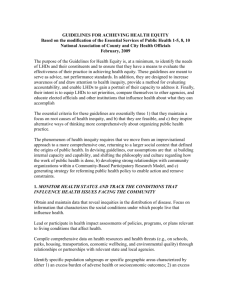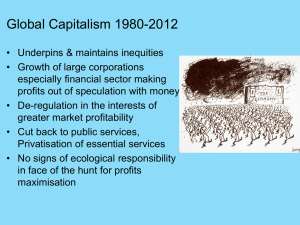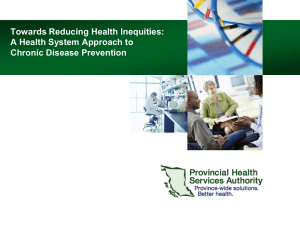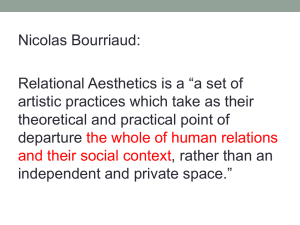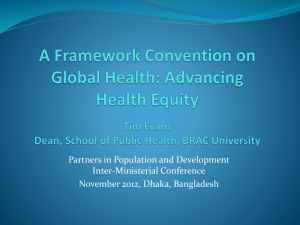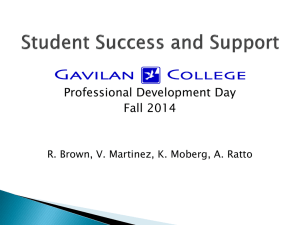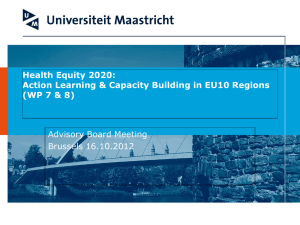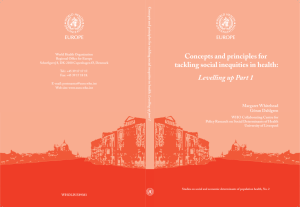Social & Health Equity - Alameda County Public Health Department
advertisement
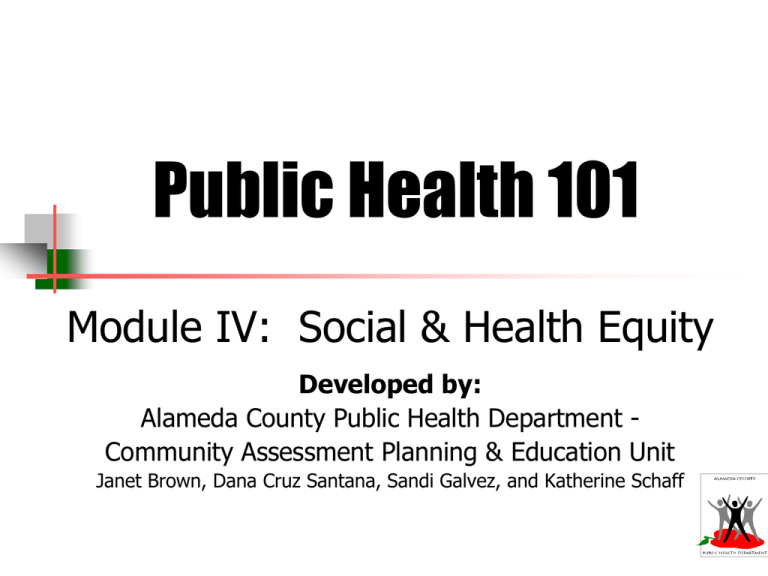
Public Health 101 Module IV: Social & Health Equity Developed by: Alameda County Public Health Department Community Assessment Planning & Education Unit Janet Brown, Dana Cruz Santana, Sandi Galvez, and Katherine Schaff Learning Objectives Increase awareness of: Historical and Current Policies Social inequities Health inequities Learn how ACPHD is planning to take action and find solutions Barnga In five tricks, your goal is to win as many tricks as possible. You will have 5 minutes to study the rules on your handout. The rules will then be taken away and NO VERBAL OR WRITTEN COMMUNICATION IS ALLOWED. You may gesture or draw pictures. Goal: Get to the winning table Barnga Remain silent and write on your half sheet of paper: How or what were you feeling? How did you interpret others’ behavior? What can you learn about yourself from this activity? Barnga—After the Activity What does this simulation demonstrate or explain? How do you think this relates to “inequity?” What Is Social Inequity? Social inequity excludes people from full and equal participation in society. Social Inequities Root Causes of Health Inequities Health Inequities Segregation Housing Income & Employment Transportation Air Quality Physical Activity & Neighborhood Conditions Access to Healthcare Education Food Access & Liquor Stores Criminal Justice Social Relationships & Community Capacity Social Inequities ACPHD’s Approach to Achieving Health Equity Policy Change HEALTH EQUITY Institutional Change Data and Research Community Capacity Building Segregation “It is often easier to become outraged by injustice half a world away than by oppression and discrimination half a block from home.” –Carl T. Rowan Author and journalist Racially Restrictive Covenant Historical Forces Have Left a Legacy of Racism and Segregation Historical Roots of Present-Day Inequities Discriminatory mortgage underwriting by the FHA/VA Redlining practices by banks and home insurance agents Racial steering and block-busting practices by real estate agents Disinvestment and concentrated poverty in urban centers Middle class and white flight to the suburbs Displacement caused by federal highway construction and other urban renewal projects Segregation and Health Low-income, segregated areas typically have: Higher density of freeways and other highly traveled roadways More sources of toxins Lower municipal service levels lower quality of life Reduced access to transportation, quality education, affordable housing, adequate parks, and grocery stores Health • Physical • Mental Finding Solutions Sample policy recommendations: Ensure equitable government infrastructure spending by neighborhood Reduce low-density-only zoning to make more homes affordable Video Clip—Invisible Wall Invisible Wall Video Clip—Invisible Wall What stood out for you? How did you feel? What are the implications for people living in the area today? Invisible Wall Today Bristol Blvd. (Last San Leandro street before Oakland city limit) 107th Avenue in Oakland (Last street before San Leandro city limit) San Leandro Today Asians (29%) & Latinos (27%) each make up a greater percentage of the population in San Leandro than non-Hispanic whites* African American residents make up about 12% of the population Discussion What is the story behind this demographic shift? What are the implications for ACPHD? Creekside? Health equity? *Census 2010 accessed at http://sanleandro.patch.com/articles/census-finds-san-leandro-bigger-and-more-diverse What issues of equity are being raised in the cartoons and/or Occupy movement? Finding Solutions Occupy movement’s public health messages Social factors are related to health: e.g., housing, income inequity Forming policy solutions e.g., “move your money”, “end corporate personhood” Transportation “My feet is weary, but my soul is rested.” –Mother Pollard, Montgomery Bus Boycott Participant Unequal Public Transit Subsidies Transportation and Health Access to health-related goods and services (e.g., health care, healthy foods) Access to employment Transportation Highway and transitrelated air pollution Vehicle miles traveled and climate change Noise pollution Physical activity levels and pedestrian/bicyclist injuries Health • Physical • Mental Finding Solutions Airport Connector – Urban Habitat vs. BART regarding civil right laws Measure VV parcel tax to preserve low cost bus passes for youth, seniors and the disabled passed with the support of 16 local organizations Effects of Social Inequities Social Inequities Body Mind Spirit Effects of Social Inequities “When the symbols, rituals, rites of one’s culture lose their legitimacy and power to compel thought and action, then disruption occurs within cultural orientation and reflects itself as pathology in the psychology of the people belonging to that culture.” (Nobles, et al., 1987) Not Quite Home: The Psychological Effects of Oppression Ken Hardy’s article “Home isn’t just a place to sleep and hang your clothes; it is also a state of being, a sense of intrinsically fitting in to the community around you and being welcomed, invited, accepted and free to be complete…Home is the spirit we hope to find in others; an end to being pushed out in the cold because of some difference that is deemed unacceptable.” Source: http://www.d.umn.edu/sw/cw/documents/NotQuiteHome_000.pdf Impact of Social Inequities on WellBeing Psychological homelessness: result of oppression and injustices by racism Historical legacy of colonization Guilt, anger, self-hate & powerlessness Fear and depression Isolation, break up of families, loss of identity and destruction of culture When the External Becomes Internal How Health Inequities Get Inside the Body Physical and Mental Health Impacts Transportation Housing Stress Stress Stress Stress Stress Increased commute times Lack of access to stores, jobs, services Segregation Stress Poor air quality Stress Stress Crime Poor quality Education Impact on Native American Health As you think about the video we just saw, what scenes stand out for you? How do you think this impacts us in accomplishing our mission of “optimal health and well-being of all people?” Group Discussion Do you recognize aspects of psychological homelessness from your youth? As an adult? Which observations have you made that you would consider manifestations of psychological homelessness? How can we address this condition in ACPHD’s health equity work? Example organization addressing psychological homelessness Instituto Familiar de la Raza, Inc. in San Francisco’s Mission District http://ifrsf.org/blog/about-us/philosophy/ What Is Health Inequity? Health Disparities “A difference in rates of illness, disease, or conditions among different populations.” –UW, Robert Wood Johnson & NACCHO Health Inequities Health inequities are “differences in health which are not only unnecessary and avoidable but, in addition, are considered unfair and unjust.” –Margaret Whitehead Department of Public Health University of Liverpool Place Matters Health Inequities by Where People Live Income Matters Health Inequities by Neighborhood Poverty Source: Alameda County Vital Statistics files and American Community Survey, 2005-09 Race and Racism Matter Health Inequities by Race/Ethnicity 5.9 years 2.3 years Note: White and African American defined regardless of Latino origin. Source: Alameda County Vital Statistics files, 1960-2009 7.9 years Racial Wealth Divide Source: Pew Research Center tabulations of 2008 Survey of Income and Program Participation and various U.S. Census Bureau P70 Current Population reports, 2011. Racial Wealth Divide For every 1$ that the median White family has the US, the typical Black family has 5¢ and the typical Latino family has 6¢. Whites Blacks Source: Pew Research Center tabulations of 2008 Survey of Income and Program Participation and various U.S. Census Bureau P70 Current Population reports, 2011. Latinos The Truth About the Economy Moving Forward Determinants of Health Levels of Interventions Socio-Ecological (society) Discriminatory Beliefs (Isms) ??? Institutional Power Social Inequities Policy Advocacy Comm. Capacity Building Medical Model (individuals) Risk Factors & Behaviors Disease & Injury Patient Clinics Education Mortality Emergency Rooms ACPHD Work Moving Forward ACPHD’s role in addressing a social and health inequities What is one useful thing that you learned or thought about today? What is one thing that you can collectively do to address social and health inequities? ACPHD Strategic Plan 1. Transform our organizational culture and align our daily work to achieve health equity 2. Enhance Public Health communications internally and externally 3. Ensure organizational accountability through measurable outcomes and community involvement 4. Support the development of a productive, creative, and accountable workforce. 5. Advocate for policies that address social conditions impacting health. 6. Cultivate and expand partnerships that are community driven and innovative. Resources Life and Death from Unnatural Causes: Health and Social Inequity in Alameda County: http://www.acphd.org/data-reports/reports-bytopic/social-and-health-equity/life-and-death-fromunnatural-causes.aspx ACPHD’s Social & Health Equity Web page http://www.acphd.org/social-and-health-equity.aspx The National Association of County and City Health Officials’ Social Justice page http://www.naccho.org/topics/justice/index.cfm Reaching for a Healthier Life: Facts on Socioeconomic Status and Health in the U.S. www.macses.ucsf.edu/downloads/Reaching_for_a_He althier_Life.pdf Resources (cont.) Spirit of 1848 listserv http://www.spiritof1848.org/listserv.htm Social Determinants of Health: The Solid Facts. WHO http://www.euro.who.int/document/e81384.pdf Why Place Matters: Building the Movement for Healthy Communities. PolicyLink. http://www.policylink.org/documents/WhyPlaceMattersrep ort_web.pdf Unnatural Causes http://www.unnaturalcauses.org Occupy Public Health http://occupypublichealth.org 10 Things to Know about Health 1. Health is more than health care. 2. Health is tied to the distribution of resources. 3. Racism imposes an added burden. 4. The choices we make are shaped by the choices we have. 5. High demand + low control = chronic stress. 6. Chronic stress can be deadly. 7. Inequality – economic and political – is bad for our health. 8. Social policy is health policy. 9. Health inequities are not natural. 10. We all pay the price for poor health. –Unnatural Causes
